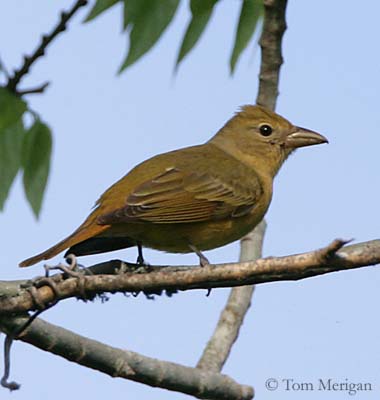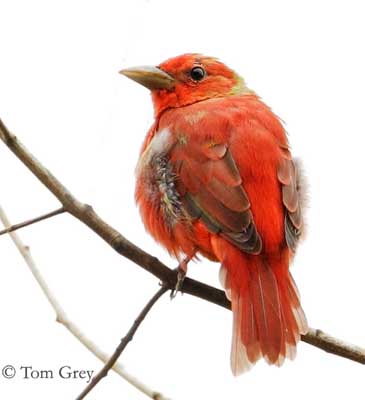
Summer Tanager
Piranga rubra
Passeriforme Order – Cardinalidae Family
BIOMETRICS:
Length : 17 cm
Wingspan : 28-30 cm
Weight : 30 g
LONGEVITY: Up to 5 years
DESCRIPTION:
Summer Tanager is a bulky bird.
DIET:
Summer Tanager is mainly insectivorous, feeding on flying and terrestrial insects, such as beetles, dragonflies, grasshoppers, ants, caterpillars. It also feeds on spiders, and may consume fruit and berries. But during summer, Summer Tanager feeds mainly on bees and wasps, adults and larvae.
PROTECTION / THREATS / STATUS:
Summer Tanager populations are stable. The most important threat for this species is destruction of breeding habitat, and collisions with towers during nocturnal migrations.
Summer Tanager has some predators such as jays, hawks, racoons, squirrels and snakes.
Fr: Tangara vermillon
All : Sommertangare
Esp : Quitrique Colorado
Ital : Piranga estiva
Nd : Zomertangare
Russe : Летняя танагра
Sd : Sommartangara
Photographs by Tom Grey
His website : Tom Grey's Bird Pictures
Photograph of the female by Tom Merigan
His website : Tom Merigan’s Photo Galleries
Text by Nicole Bouglouan
Sources :
A GUIDE TO THE BIRDS OF MEXICO AND NORTHERN CENTRAL AMERICA by Steve N. G. Howell, Sophie Webb - Oxford University Press - ISBN: 0198540124
BIRDS OF THE GREAT BASIN – by Fred A. Ryser - Univ of Nevada Pr -ISBN: 0874170796
FIELD GUIDE TO THE BIRDS OF NORTH AMERICA by National Geographic Society - National Geographic Society - ISBN: 0792274512
All About Birds (Cornell Lab of Ornithology)
Animal Diversity Web (University of Michigan Museum of Zoology)
What Bird-The ultimate Bird Guide (Mitchell Waite)
Wikipedia (Wikipedia, The Free Encyclopedia)

Adult male has rose-red plumage overall, with wings and tail slightly duller. Summer Tanager retains red plumage year-round.
Conical, strong bill is horn coloured, becoming darker in winter. Eyes are dark brown. Legs and feet are pale grey-brown.

Female has dull brownish-olive plumage with narrow yellowish edges on wing coverts. Wings appear to have same colour as body.
Some females may show overall reddish wash, or red tinge on wings, tail and body.
Immature male has spotted plumage, with orange-red patches on yellowish plumage.
We find two subspecies: Piranga rubra cooperi in the west, and Piranga rubra rubra in the East.
We can also find similar species:
Scarlet Tanager – Piranga olivacea – is bright red with black wings.
Hepatic Tanager –Piranga flava – is dull greyish-red with dark bill and legs, and darker wings and tail. Both male and female have grey facial patch.
Oriole females show white wing bars and pointed darker bills.
VOICE: SOUNDS BY XENO-CANTO
Summer Tanager’s calls are loud, clicking, including two notes “pik-i-tuck”. Intensity may vary. When near rivals, male gives faster and rolled version “prrit-i-tuk-tuk-tuk”. When bird is alone and quiet, call is slower “pi-tuk”.
During territorial disputes, we can hear whining “cheeew”. These calls are often accompanied by flights back and forth between perches, and other aggressive postures with raised and fanned tail, fluttering wings, and erected head feathers.
Summer Tanager’s song is a sweet, clear series of carolling whistled notes. Songs have real musical quality, rather thrush-like phrases.
HABITAT:
Summer Tanager breeds in open woodlands of oak or pine-oak, riparian woodlands of cottonwoods and willows, and it also may be found in orchards and parks. Eastern birds prefer open deciduous woods, and western birds occupy riparian woodlands.
It winters in open woodlands, forest edges, trees in parks and gardens in cities. In Mexico, it inhabits humid evergreen forest, and tropical deciduous forest.
RANGE:
Summer Tanager breeds in southern United States and northern Mexico, northwards in east to southern Iowa and New Jersey.
It winters from southern Mexico, southwards to northern South America.
BEHAVIOUR:
Summer Tanager captures flying insects, performing short sallies from perches. It gleans for food from leaf and bark surfaces in trees and shrubs. It may capture prey on the ground, but prefers foraging in trees until top of canopy.
Summer Tanager feeds on adult bees and wasps, caught by hawking. It carries its prey to a perch and beats it repeatedly against perch until dead. Then, it removes stinger by wiping prey on branch before to swallow it. It also captures larvae after killing or harassing adults until they abandon the nest. It feeds on fruit too, sometimes by hovering and plucking fruits.
Summer Tanager moves by hopping into vegetation from perch to perch, and also on ground.

Territorial disputes occur when males arrive on breeding grounds in mid-April to late May. Males compete for territories, and may come into physical contacts after chasing. Same kind of chases may be directed at females during courtship.
Males defend nesting and feeding areas. They establish boundaries by intense singing and calling, chasing rivals away from territories. Interactions with neighbours decline rapidly when territories are established.
Summer tanager is often seen alone, but during courtship, mates feed together. Summer Tanagers seem to be monogamous for the season. Courtship begins with frequent and energetic chases of the female by male. Male may bring food to female during incubation, hopping with raised crest and tail, and fluttering wings while it sings and calls very softly. Copulation occurs when female postures by extending wings outwards and lifting tail upwards. Pair bonds may disappear after young disperse.
Summer Tanager migrates in flocks of up to 30 birds. This species is highly migratory, mainly at night, sometimes by day.
It responds to predators by mobbing intruders, diving with quick swooping flights while calling strongly.
FLIGHT:
Summer Tanager has swift and direct flight. Rapid wing beats and brief pauses alternate during longer flights. It is an excellent flycatcher, able to capture bees and wasps in mid-flight.

REPRODUCTION:
Summer Tanager searches for nest-site two to four weeks after arrival on breeding grounds. Male and female seem to search together.
Female gathers nest material and builds the nest. Male often follows her, but does not participate. Nest is usually placed among cluster of leaves, or in fork of branches, at variable height, from 1, 30 to 22metres, but usually about 4 metres above the ground.
Open-cup nest is made with dried grasses, weeds, leaves, spider webs and strip of bark. Female weaves materials in crude fashion. It is often a loose construction, so thin that eggs can be seen through the bottom. In other parts of the range, particularly in western parts, nest is well constructed. She lines nest with fine grasses.
Female lays 3 to 4 pale blue or pale green eggs, spotted with brown. Incubation lasts about 12 to 13 days, by female, sometimes fed by male when she begs him for food. Altricial chicks are fed by both parents, male giving food to female who gives it to chicks. Young leave the nest about 8 to 10 days after hatching. They start to fly at 10 days. Adults and young stay together for two to four weeks after fledging.
This species produces only one brood per season, and birds leave breeding grounds in September and October.
